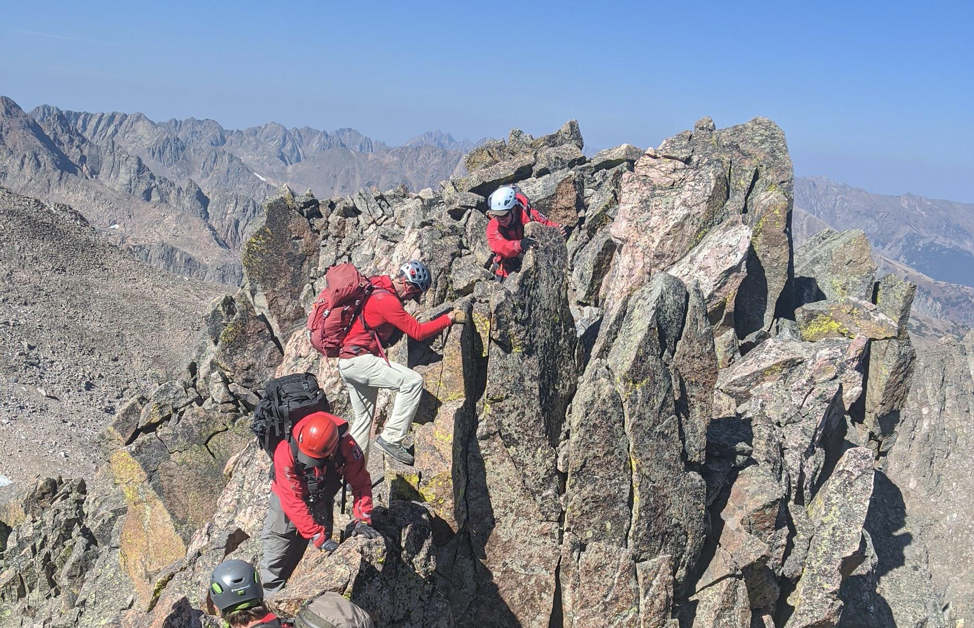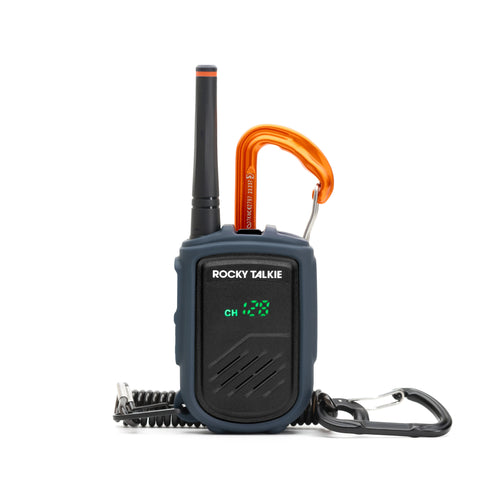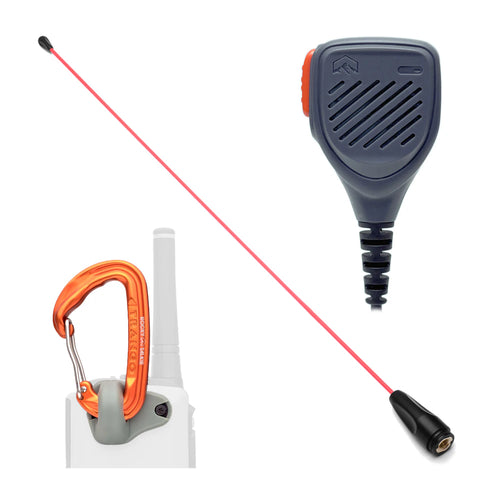
Multi-day Extraction with a Blizzard Coming
| 6 min read | 8 CommentsOn the morning of October 7th, a local hiker from Lakewood, Colorado, set out for his last peak.
It was Mt. Silverthorne, a gorgeous 13,300-foot mountain deep in Colorado’s Gore Range. He took his SPOT personal locator device, like he always did, to let his wife know where he was. All through the morning it set off tiny pings to share his progress.
At 2:20 pm, it transmitted a photo, a smiling summit selfie from a rocky peak.
At 3:00 pm, it showed him picking his way carefully down the descent.
At 4:30 pm, it stopped.
A few hours later, Summit County Rescue Group got the call to go looking.
---
With another rescue mission going on that day, the group was strapped for volunteers, but they managed to deploy three small teams to scour the trails around Mt. Silverthorne. The volunteers spent all night looking, but by the time they rendezvoused, exhausted, around 4:00 am, no one had seen or heard anything.
There was nothing out there—just the rocks and the wind.
The mission coordinator immediately put out another call for fresh searchers. This was the morning of October 8th, and with an early-season snowstorm forecast for the 10th, they didn’t have much time. Once the snow started, conditions would be too dangerous for rescuers, let alone a stranded solo hiker.

On the second day, a team used a helicopter to search from the air. Photo: Sage Miller
This time, 20 volunteers responded to the call, and fresh teams started hiking as early as 4am.
One team, led by longtime volunteer Sage Miller, was dispatched by helicopter. He remembers staring out the chopper window like his life depended on it. They flew low and slow, combing the terrain with binoculars until they were right above the patient’s last known location, that last ping from the SPOT device.
It was on the north side of East Thorn, right in the worst of it: a loose, vertical couloir slicked over with ice and last-season’s snow. They flew over a few times, but the couloir was a maze of boulders and scree. Even if the patient was in there, he could be impossible to spot.
They’d have to go on foot.

Miller’s team navigated loose rock and granite gendarmes to reach the last known location. Photo: Whit Smith
Mt. Silverthorne is an accessible mountain, class II at the most, and easy hiking. East Thorn, on the other hand, is fifth-class terrain—all knife-edged ridges and toothy towers that climbers have to hug or circumnavigate to cross. The patient must have wandered off route, they realize. Up here, it was an easy mistake; there were no trails.
The other thing about East Thorn is that it’s notorious for rockfall. Just a few years back, a flank of the mountain peeled off and fell, a major rockfall event you could see and hear from town.
---
The helicopter dropped the team of five on the saddle between Mt. Silverthorne and East Thorn. They shouldered packs and ropes and began picking their way east.
Miller and the others weaved through granite spires, trying to avoid loose rock and wobbling boulders as much as they could. As they neared the couloir, one of the volunteers, Hunter Mortenson, spotted something. Someone handed him the binoculars, and he peered closer.
The team passed the binocs back and forth. Maybe the rocks were playing tricks on their tired minds. But after a few minutes of taking turns, the shapes seemed to resolve. There was a shoe, and backpack. Both 500 feet down and covered with a film of dust.
Miller felt a wave of relief and despair. Relief for other teams: After searching to exhaustion for 14 total hours, they could finally head down. Despair for the hiker’s family: He was dead. All they could do for his loved ones now was find a way to bring him home.

Miller and Milroy rappel the couloir down a boilerplate sheet of frozen snow. Photo: Hunter Mortenson
But first they had to get to him. They decided to split up—one team would descend the main couloir where a safer descent seemed possible. The others would try to access the patient from a more direct, albeit more dangerous, route. Those in the “safer” couloir were aiming for what they thought was a patch of soft, stable snow.
It wasn’t. It was a sheet of ice. Miller hit it, nearly slipped, caught himself, and paused to look around. Everything here—all the rocks, all the scree, was plated in black ice. Up until this point, the team had tried to travel without ropes, but now they had no choice. There was no walking on this stuff, no way to access the others, and no way to get back to the ridge. So as carefully as they could, they set up a rappel.
By the time the other team got to the patient, it was past 6:00 pm. They paused in silence for a moment. The patient’s helmet was shattered. His SPOT device was in pieces. He’d fallen a long way.
But he was on a steep slope, surrounded on all sides by loose rock and snow. It wasn’t safe to linger. They were in a rockfall zone, and they needed to get down before dark. As hard as it was to get here, they’d have to come back tomorrow.
A series of rappels, pendulums, snow traverses, and lowers got the team back to the moraine at the base of the couloir. By now, the moon was out. Miller sighed. It was the night of his wedding anniversary. He spent the walk out crafting his apology in his head.
They now only had one more day to get the patient out before several feet of snow descended across the range. And the route they’d taken today? There was no getting a litter down that.

The technical terrain necessitated a massive extraction operation. Map: Sage Miller
They would need a helicopter. The trouble was, they couldn’t get one.
That night, Summit County Rescue Group called the National Guard, asking for a chopper with a hoist that could pluck the patient out of the couloir and carry him home to his family. But the National Guard declined the request.
Other helicopter services would cost up to $20,000 a day—a cost the volunteer group couldn’t cover and didn’t want to pass on to the victim’s family, who had been through enough.
The last option: hauling the patient 500 feet up to the ridge by hand, and lowering him the whopping 1,500 feet down the other side.
By the time Miller and his crew got back to incident command, it was 11:00 pm, but they immediately launched into next-day planning. After all, there was no time to waste: a storm was coming.

Volunteers Zac Cohen and Devon Haire prepare for the initial uphaul. Photo: Chris Wilson
On the morning of the ninth, a Flight for Life helicopter volunteered one of its crews to stand by at the base of East Thorn—at no charge. It was as close as they could get to the patient, and the chopper didn’t have a hoist. Still, the lift would save the volunteers miles of hiking with a full litter, an operation that would extend into the night without helicopter assistance.
That morning, 15 Summit County Rescue Group members drove across the county to gather at Mt. Silverthorne. Eighteen more volunteers from neighboring counties, who had heard about the impossible task ahead, showed up to help, one by one, until the parking lot was filled with rescuers. Hauling a human being down a mountainside is back-breaking work. They would need everyone they could get.

Miller signals to the Flight for Life Helicopter to help it land near East Thorn. Photo: Steve Milroy
They hiked up together that morning. But because of the rockfall hazard, it was only safe to send one volunteer, Devon Haire, down to the patient. Alone, he packaged up the litter, ducking for cover every time his ropes brushed against loose rock above him and sent it crashing down.
It took two and a half hours to reach the body, an hour to package him, and a full hour to complete the 500-foot haul up to the ridge at 4:30 pm.
Waiting volunteers swarmed in to begin the lower: 1,500 vertical feet over about a half mile. It took 45 people, 3,000 linear feet of rope, and four and a half hours to complete.
Around 9:30 pm the rescuers carried the litter into the waiting chopper. That night, he was delivered home.
---
The rescue was hardly publicized. No life was saved, and so there was no glory or fanfare. But dozens of volunteers came together, facing trauma and personal risk, to do this one meaningful thing for a member of their community. They lost sleep, left the safety of their homes, and called out of work. Others returned to their jobs after all-night searches. Family dinners were eaten without their loved ones, and even wedding anniversaries were postponed
But, Miller says, for every one of those rescuers, it was worth it.

After a three-day effort by more than 45 volunteers, the patient’s body was lifted into the waiting helicopter and delivered to his family. Photo: Anna Debattiste
8 Responses
Leave a comment (all fields required)
Comments will be approved before showing up.















Burton Short
|
Mar 01, 21
Burton Short
|
Mar 01, 21
David Siderfin
|
Mar 01, 21
Mike Januszkiewicz
|
Mar 01, 21
Jason DiMinico
|
Mar 01, 21
Ann Logan
|
Mar 01, 21
Ann Logan
|
Mar 01, 21
John
|
Mar 01, 21